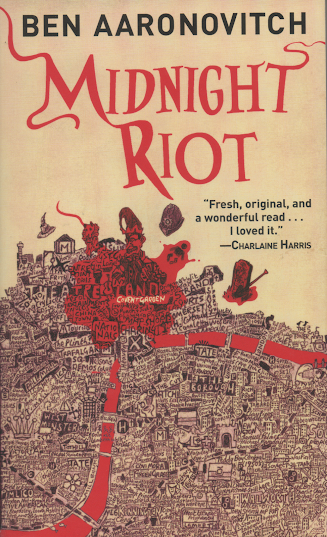First impressions review: Midnight Riot, by Ben Aaronovitch
This is the first in a series of urban fantasy police procedural novels featuring probationary constable and apprentice wizard Peter Grant. Peter is about to have his career with London’s Metropolitan Police diverted into permanent paperwork when he gets an unexpected break: a witness testimony to a murder. Inconveniently, the witness is a ghost! This brings him to the attention of Detective Chief Inspector Nightingale, who is to the Met as Fox Mulder is to the FBI in ‘X-Files’. The murderer they are tracking is a some kind of spirit who can possess people’s bodies and force them to act out scenes from ‘Punch and Judy’ – a puppet act with probably the highest on-screen bodycount of any children’s media! Along the way, they also get involved in a dispute between two families of water deities who both claim the Thames.
The tone of this book gives me strong Pratchett vibes, especially Discworld’s Watch. For instance, the first page reads like this:
It started at one thirty on a cold Tuesday morning…when Martin Turner, street performer and, in his own words, apprentice gigolo, tripped over a body…Martin gave the body the ‘London once-over’ – a quick glance to determine whether this was a drunk, a crazy, or a human being in distress. The fact that it was entirely possible for someone to be all three simultaneously is why good-Samaritanism in London is considered an extreme sport…
Peter as a narrator isn’t quite as cynical as Vimes, but he does all right for his age, and there are lots of wry asides. For instance, he is mixed race and is very aware of how whether he’s been out in the sun lately leads people to peg him as either black or middle-eastern, and how that (plus how scruffy he happens to be looking at the time) affects their assessment of him as a threat. Like Vimes, he views coppers as fundamentally working-class but is self-aware about also being the arm of the state. He describes the customary greeting of copper to civilian as “Oi! …What do you think you’re doing?” and speaks of falsifying paperwork as a cherished tradition.
Nightingale, the only senior wizard copper, is an intriguing character who we don’t learn nearly enough about in this book – but perhaps that is being saved for the sequels. He’s well dressed and rather old-fashioned…conveniently, it turns out, since the more scientifically-inclined Peter discovers that doing magic tends to break any modern electronics in the vicinity. Their department headquarters/Nightingale’s home is a fancy old building known as the Folly, looked over by a silent housemaid named Molly, who is some kind of vampire-like creature. In spite of this she can cook quite well, though she seems to have no sense for appropriate portion sizes. To begin the magic lessons, Nightingale teaches Peter how to read vestigia (magical after-images), and how to make a fireball without burning his hand off.
Other characters include Leslie – a fellow probationary constable Peter has a crush on – and the extended families of Mother Thames and Father Thames. Mother Thames turns out to be Nigerian, having taken over the estuary portion of the river abandoned by Father Thames (who now hangs out near the source and resembles an old white British farmer) during the Big Stink of the 1800s. Her daughter Beverly Brook is rather saucy and fun and an alternate love interest for Peter – though he has some doubts about the wisdom of getting too involved with water sprites.
The social commentary present in this story makes for fun, biting asides, but doesn’t really rise to much significance. While any story featuring police as the heroes could be considered “copaganda”, one thing I appreciated about the Discworld version is the way large powerful forces in society usually end up being the main threat, rather than some random maniac. This story, on the other hand, isn’t really challenging any cultural or genre assumptions (see this interesting video on what "spooky cops" shows have to say about attitudes to policing). In fact, it is not clear why Peter and Nightingale are cops at all, except for the convenience in getting intel. They can’t arrest ghosts or vampires because such being aren’t official acknowledged as real, making covered-up extrajudicial killings the primary solution. Yikes! I also found Peter’s constant thoughts about Leslie or Beverly’s bodies to be rather annoying. Understandable, mind you – most of us have thoughts like that – but unnecessary. It’s not like he’s telling us every time he has to sneeze or go to the bathroom, so he’s clearly filtering some things! Possibly I noticed this more because we only have Peter's perspective, making this feel more objectifying than it might if the women were also POV characters.
Overall
recommendation: I’d say this
is a good choice for a breezy, if sometimes gruesome, travel read. While not as
individually satisfying as one of the Discworld books it resembles, it was entertaining
and a decent start for a series. The life and
face-attachment-status of one of the main characters is also left on a bit of a
cliff hanger! I hope later books tell the reader more about Nightingale,
and maybe address the ethics of Peter and Nightingale essentially being state-supported vigilantes.


